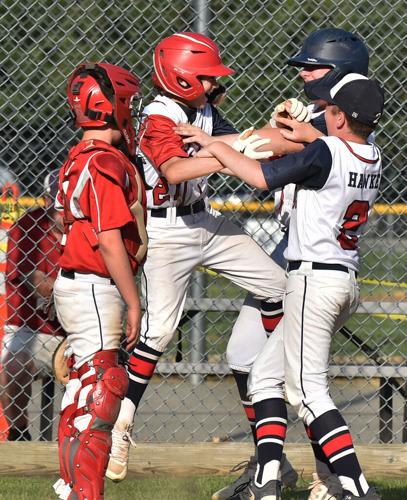There are 9 innings in a game of baseball. Baseball games consist of 9 innings, with each team taking a turn batting and fielding for an inning.
It is a popular sport that originated in the United States and is played by millions of fans across the globe. The game is known for its strategic play, teamwork, and individual skill. Each team aims to score runs by hitting the ball and advancing around a series of bases.
The game continues until all 9 innings are completed, or if there is a tie, extra innings may be played. Baseball is a beloved pastime that has captivated fans for generations.

Credit: www.13abc.com
Understanding The Basics Of Baseball
Are you new to the world of baseball? Don’t worry, we’ve got you covered! Before we dive into the intricacies of this beloved sport, let’s start with the basics. In this section, we will explore what exactly baseball is and how a typical game is structured. So, grab your gloves and let’s get started!
What Is Baseball?
Baseball is a thrilling sport that has captured the hearts of millions around the world. Imagine a game where players make incredible catches, hit powerful home runs, and showcase their lightning-fast agility on the field. Baseball is a bat-and-ball game played between two teams, each consisting of nine players.
- It originated in the United States in the 18th century, and ever since, it has become one of America’s favorite pastimes.
- Baseball is played on a diamond-shaped field made up of four bases – first, second, third, and home plate.
- The objective of the game is for one team to score more runs than the other by hitting the ball with a bat and advancing around the bases.
- While the game may seem simple at first glance, it involves a strategic balance of offense and defense, making it both mentally and physically demanding.
Now that we have a basic understanding of what baseball is, let’s explore the structure of a typical baseball game.
How Is A Baseball Game Structured?
A baseball game consists of innings, which are divided into halves known as the top half and the bottom half. Each team gets a chance to bat and field during these halves, aiming to outscore their opponent. Here is a breakdown of the game’s structure:
- The top half of the inning: The visiting team takes their turn at bat, trying to score runs. The defensive team, known as the home team, takes the field and tries to prevent runs from being scored. This half ends when the defensive team records three outs.
- The bottom half of the inning: Now, it’s the home team’s turn to bat and the visiting team’s turn to field. The scenario is reversed, and the offensive and defensive teams switch roles. Similarly, this half ends when the defensive team gets three outs.
- Repeating the innings: This cycle of alternating halves continues until both teams have completed nine innings. In the case of a tie after nine innings, extra innings may be played to determine the winner.
Each inning provides an opportunity for teams to showcase their skills, with intense rivalries and thrilling moments often defining the outcome of the game.
Now that you have a solid understanding of baseball and how a game is structured, you’re ready to dive into the fascinating world of this timeless sport. Stay tuned for more exciting insights!

Credit: www.salemnews.com
Exploring The Concept Of Innings
In the game of baseball, one of the fundamental concepts that every fan should understand is the innings. Innings are the building blocks of a baseball game, serving as the divisions that allow teams to take turns on offense and defense. So, let’s embark on a journey to explore the concept of innings and unravel the mysteries behind this crucial element of America’s favorite pastime.
What Is An Inning In Baseball?
An inning is a unit of play in baseball, consisting of two halves – the top and the bottom. Each team gets a chance to both bat and field during an inning. In the top half, the visiting team takes their turn to bat and try to score runs, while the home team defends as the fielding team. The roles reverse in the bottom half, with the home team getting a chance to hit and the visiting team taking the field.
Each half-inning is further divided into three outs. An out occurs when the batter fails to safely reach a base or when a fielding team successfully records three outs, signaling the end of the half-inning. The ultimate goal for both teams is to score as many runs as possible within the allotted nine innings.
Why Are There Nine Innings In A Baseball Game?
Have you ever wondered why baseball games are typically played over nine innings? The origin of this convention can be traced back to the early days of baseball. When the rules of the game were first established in the 19th century, it was agreed upon that nine innings provided a fair balance between allowing each team ample opportunities to bat and field while maintaining a manageable game length.
Over time, the standardization of nine innings became deeply ingrained in baseball tradition. This duration allows for an ideal balance of strategy, competition, and the ebb and flow of the game. Additionally, nine innings provide fans with enough action and excitement to stay engaged throughout the course of the game.
Do Innings Have A Specific Time Duration?
Unlike sports with fixed time limits, such as basketball or soccer, baseball innings do not have a specific time duration. The length of each half-inning can vary based on several factors, including the number of hits, walks, pitching changes, and even weather delays. As a result, the duration of a baseball game can vary greatly, ranging from a brisk two hours to well over four hours.
The absence of a specific time limit in baseball adds an element of suspense and uncertainty to the game. It means that no matter how big the lead or how small the deficit, there’s always a chance for a team to mount a comeback and turn the tides in their favor. This unpredictability is one of the many reasons why baseball has captured the hearts of millions of fans around the world.
Understanding Additional Innings In Special Situations
Baseball is a game filled with excitement and anticipation, and sometimes, nine innings just aren’t enough to determine a winner. Understanding what happens in extra innings, whether there are different rules for playoff games, and how a tie game impacts the number of innings played, will help you fully grasp the intricacies of the game. Let’s dive right in!
H3: What happens in extra innings?
When a regular baseball game is tied after the completion of nine innings, additional innings are played to determine a winner. In extra innings, each team receives the opportunity to bat and play defense until one team outscores the other.
In each inning, the visiting team has the first chance to bat, followed by the home team. This pattern continues until the game reaches a decisive conclusion. Teams will continue to play extra innings until a winner is declared, regardless of the number of innings it takes.
H3: Are there different rules for playoff games?
During the regular season, extra innings follow the same rules as the rest of the game. However, in playoff games, certain adjustments are made to ensure a timely conclusion and avoid exhaustive marathon matches.
Starting in the 10th inning of a playoff game, each team begins its offensive half-inning with a runner on second base. This rule, known as the “runner on second rule,” aims to increase the likelihood of scoring and speeding up the game. The runner is typically the player who made the last out in the previous inning, but this can vary depending on league rules.
H3: How does a tie game impact the number of innings played?
Baseball games strive for a clear victory, but occasionally, games end in a tie due to various factors such as weather conditions or time restrictions. However, ties are a rarity in professional baseball, as the game traditionally continues until a winner is determined.
In the rare event of a tie game, additional innings will be played until a winner is obtained. This means that the game could theoretically continue for many more innings until a decisive outcome is achieved, regardless of the duration.
A tie game should be seen as an opportunity for both teams to showcase their skills and determination while thrilling fans with extra innings of baseball action.
Whether you’re a seasoned baseball fan or just starting to learn about the sport, understanding the ins and outs of extra innings is crucial. Knowing what happens in extra innings, the different rules for playoff games, and the impact of a tie game will enhance your appreciation for the excitement and strategy that baseball brings to the table.

Credit: www.kfvs12.com
Frequently Asked Questions On How Many Innings In Baseball? Read This First!
How Many Innings In A Baseball Game?
A baseball game consists of 9 innings, with each team having a chance to bat and field in each inning. However, extra innings can be played if the game is tied after the 9th inning, extending the game until a winner is determined.
Why Are There 9 Innings In Baseball?
The tradition of 9 innings in baseball dates back to the early days of the sport. It provides a balanced structure for both teams to have equal opportunities to bat and field. Additionally, 9 innings allows for a reasonable duration of play while still maintaining the excitement and suspense of the game.
How Long Does An Inning In Baseball Last?
The duration of an inning in baseball can vary depending on various factors such as the number of runs scored, pitching changes, and game situations. On average, an inning can last around 20 minutes, but it can be longer or shorter depending on the circumstances.
Can Baseball Games Have More Than 9 Innings?
Yes, baseball games can have more than 9 innings if the game is tied after the 9th inning. In such cases, extra innings are played until a winner is determined. These additional innings continue until one team scores more runs at the end of a complete inning.
Conclusion
Understanding the number of innings in a baseball game is crucial for fans and newcomers alike. With a standard of nine innings, each comprising of two halves, the game offers a thrilling and immersive experience. Whether you’re watching from the stands or cheering from home, knowing the ins and outs of innings adds depth to your baseball knowledge.
So, grab your popcorn and enjoy this timeless sport!

General Manager & Auditorial Head.
Killian Jake is a World Sports Traveler and hobbyist sports lover. By exploring different sorts of playing modules like indoor, outdoor, and many more. As for professionalism and writing, it’s helpful to give you the right suggestions on different games and sports.





